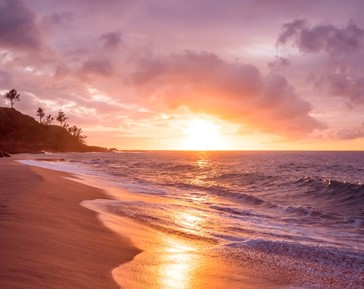
With the heat of the day slowly fading as the evening approaches, the Florida sun begins its descent below the horizon. As it dips lower toward the ground, the day’s remaining clouds explode into a vibrant burst of fiery oranges, majestic purples, and simmering reds. Warm winds blow out across the shoreline, seemingly extinguishing the last remaining beams of light before the sun disappears into the night.
Ashley Roberts of Tampa Bay, Florida says it’s an extraordinary event that happens every day along the coast—in a state famously nicknamed the sunshine state. But to understand what makes the United States’ southernmost peninsula such a hotspot for stunningly beautiful sunsets, we first have to analyze its climate, air quality, and infrastructure.
Come for the Tropical Weather, Stay for the Stellar Skies
Looking at it on a map, Florida might not seem very large, but from north to south, the state runs more than 500 miles into the Gulf of Mexico. From its southernmost tip, visitors are technically closer to Cuba and the Bahamas than they are to Alabama or Georgia. This undoubtedly has an impact on the state’s daily weather and seasonal climate.
Unlike the rest of the country, parts of Florida fall within the tropical belt where seasons fluctuate not between hot and cold, but wet and dry. This means that, for several months of the year, Florida receives almost daily rain before slipping into a drier period during the traditional “winter” months.
Visitors and locals alike know from firsthand experience that the wet months are guaranteed to produce jaw-dropping sunsets. Thanks to the extra moisture in the air, the light of a setting sun refracts into a dazzling light show of reds, pinks, purples, and oranges. On truly magical nights, the sky will even turn an amber gold before fading into cotton candy hues.
Less Pollution Contributes to Clearer Sunsets
Florida isn’t exactly a rural state, considering that Orlando, Miami, and Jacksonville attract so many visitors from around the world. That said, though, it is far less urban than, say, California or New York. This supplements the low amount of air pollution, especially along the coasts where visitors and locals flock to witness nightly sunsets.
Thanks to its cleaner environment and clearer skies, Florida natives are able to make the most of the state’s natural beauty. Of course, as developments continue to expand across the state, it’s uncertain whether this will remain the case forever. If the locals have anything to say about it, though, Florida’s picturesque environment won’t be going anywhere.

Skylines Built with Sunsets in Mind
Last but not least, it wouldn’t be right to avoid mentioning Florida’s skylines. While it’s true that Miami is home to the nation’s third-tallest skyline, the majority of the state has opted for a more reserved approach to building skyscrapers. This way, visitors can continue to enjoy the sunset without buildings blocking their view.
The Bottom Line
Whatever the reason for a visit may be, all anyone needs to know is that Florida is home to some of the most stunning sunsets in the world. Thanks to the perfect balance of moisture, warmth, clean air, and an expansive, open shoreline, locals and tourists alike can enjoy nature’s own work of art.

